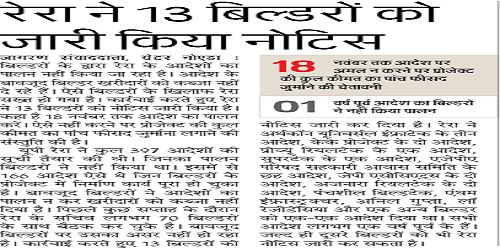RERA Has Sorted Out Most Of The Problems From A Consumer’s Perspective.

The Maharashtra Real Estate Regulatory Authority (MahaRERA) will complete a year on May 1. While the Real Estate Regulatory Authority (RERA) was supposed to be rolled out across the country the same time last year,
not all states were able to do so.
As such, today, the progress in Maharashtra has surpassed that in all other states. Niranjan Hiranandani, managing director, Hiranandani Group, tells FE’s Shubhra Tandon how the real estate sector in the state has benefited with the implementation of RERA. Excerpts:
How has the implementation of RERA been so far in Maharashtra?
RERA has been adopted in its true spirit in Maharashtra. Of the 25,000-odd projects registered in the country, 15,000 are in Maharashtra, and that’s because the state has been proactive in implementation. RERA has sorted out most of the problems from a consumer’s perspective. However, from a developer’s perspective, there are two challenges—providing for more equity and more liquidity. The money that comes can be used only for the projects.
Sometimes, it so happens that sales are short because the market is in recession, so how do developers really fund these projects? We are challenged over there. In addition, a lot of pre-sales used to take place even before the building was launched, which is banned now. So, developers are gradually getting used to this new operating environment, which is good; RERA’s operations prospectively look very good. Also, we have a strong person in Gautam Chatterjee, who is actually executing it (MahaRERA), passing orders, putting everything on website and making the process transparent.
What is the complaint resolution mechanism like?
RERA has started a conciliation cell, of which I am also a party. In fact, 40-50% of the problems are getting sorted out at the conciliation level itself. If a consumer has filed a case against a builder, there is an option to either hear it before MahaRERA, for which she has to pay Rs 5,000, or come to conciliation and pay Rs 1,000. This is another example of pro-activeness with regards to RERA.
How does the conciliation cell work?
There are five centres of conciliation cell in Mumbai, and in all 10 centres in Maharashtra, where one member represents the developer body and one member from the Mumbai Grahak Sangh. We sit as a bench together and try to resolve the issues. Only thing is that the order of the bench is not a judicial order.
What has been the success rate in matters before the conciliation cell and MahaRERA?
There are very few cases where we still don’t have a solution. These are mostly old matters, where problems continue to persist. So, that’s still a challenge. There are some cases that have gone into the cancer stage—if they are at sickness levels, we are able to resolve them. However, in Maharahstra, I would take 10-15% cases which are in that extreme stage. In Delhi NCR, I would say these stand at 80-85%. So, we look good as compared to them. I wouldn’t think 10-15% is good, but when you compare them with Delhi NCR, our builders look like saints!
The biggest fear was that the compliance with RERA will slow down new project launches…
It’s a short-run problem. About 30% of the launches are not taking place which would have taken place but for this. However, from a consumer point of view, it is a good thing that they are getting launched later with more certainty on delivery.
Has infrastructure development in Mumbai boosted the real estate sector?
Absolutely; the story is now on the ground. If you look at the Mumbai Metropolitan Region (MMR), there are 5-6 major projects. About 170 km of metro project has already started rolling and they are talking of 250 km now. Today, we have 190 km of suburban rail—Western, Central and Harbour lines, and then a cross-harbour bridge (Mumbai Trans Harbour Link), which is going to connect to the mainland. The Navi Mumbai airport is coming up. You have the coastal road on the western side and the soon-to-be-launched Roll-On Roll-Off (Ro-Ro) connectivity to Alibaug.
If you total the investments that the government is putting in … in the last 65 years, we have not spent Rs 65,000 crore, but now in the next five years, we are going to spend Rs 1,70,000 crore at the very least. For this, 70-80% of the debt is already tied up and the work has already started. What this means is that, for the first time, you are going to see urban infrastructure move at a very high pace. Overall, the opening up of peripheral areas will take place. For example, the cross-harbour bridge. In the MMR—which includes CIDCO (City and Industrial Development Corporation of Maharashtra), Navi Mumbai, Panvel right up to Khopoli—you have land equivalent to the land area of Mumbai lying vacant. If all that is added to Mumbai, there is no shortage of land—which is a big boost for the real estate sector.
Source from:-https://www.financialexpress.com/opinion/rera-has-been-adopted-in-its-true-spirit-in-maharashtra-niranjan-hiranandani/1135488/





